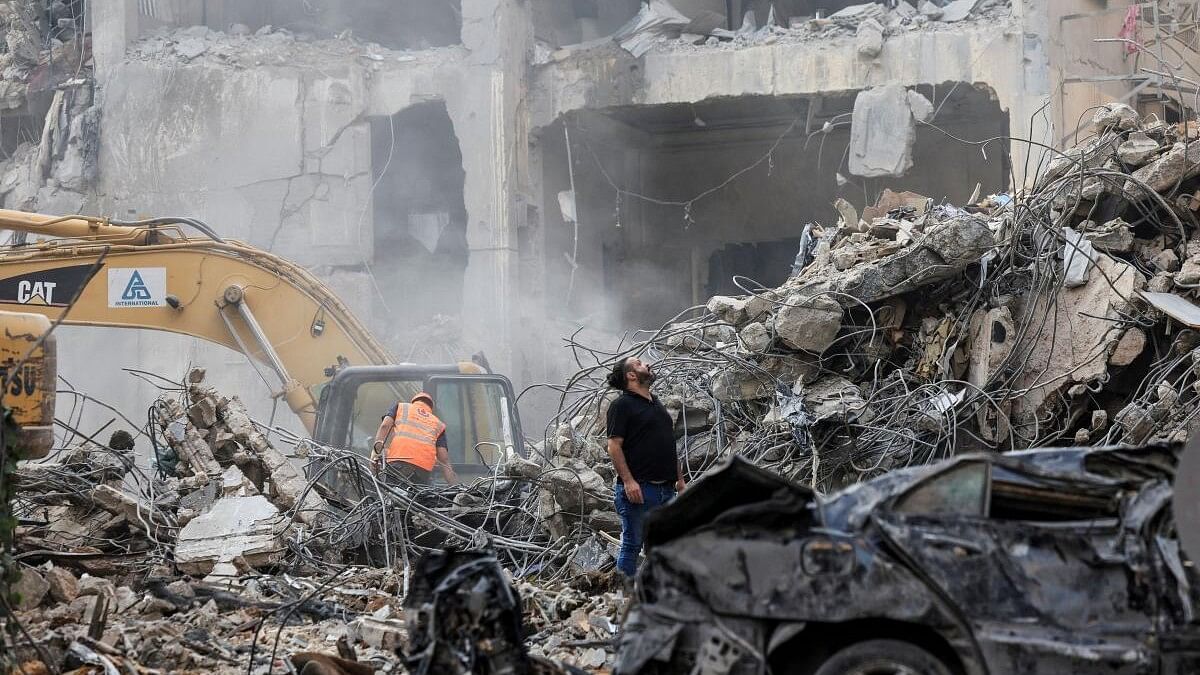
Civil defense members and rescuers work at the site of an Israeli strike in Beirut's Basta.
Credit: Reuters Photo.
The Lebanese militant group Hezbollah has been using an advanced missile against Israel that was reverse-engineered from an Israeli weapon it captured in a past war, according to Israeli defense officials.
Hezbollah fighters are believed to have seized the original Israeli Spike anti-tank missiles during the 2006 Israeli-Hezbollah war in Lebanon and shipped them to their main state backer, Iran, for cloning, Israeli and Western defense officials and weapons experts say.
Eighteen years later, Hezbollah is firing the rebranded Almas missiles at Israeli military bases, communication systems and air defense launchers with enough precision and power to pose a significant challenge for Israeli military forces. The missiles have a range of up to 10 miles and carry advanced guidance seekers to track and lock onto targets.
That Iran and its proxy forces have cloned weapons systems to use against the very adversaries who designed them is not new. Iran, for example, has copied American drones and missiles.
But the Almas missile is an example of an increasing use of Iranian-engineered weapons that is “fundamentally altering regional power dynamics,” according to Mohammed Al-Basha, a Middle East weapons analyst who runs a risk advisory firm based in Virginia.
“What was once a gradual spread of older missile generations has transformed into rapid deployment of cutting-edge technology across active battlefields,” Al-Basha said this past week.
Almas missiles are among Hezbollah weapons stockpiles that Israeli forces have captured since the start of their invasion of Lebanon about two months ago, said the Israeli defense officials, who requested anonymity to discuss sensitive intelligence.
The missiles have stood out as some of the more sophisticated weaponry among a large cache of mostly lower-quality munitions, including Russian-designed Kornet anti-tank missiles. The Wall Street Journal reported this past week that Israeli troops advancing in southern Lebanon were finding large stockpiles of Russian weapons that enhanced Hezbollah’s fighting capacity.
The Almas, which means diamond in Arabic and Persian, is a guided missile that does not need a direct eye-line sight to launch from land vehicles, drones, helicopters and shoulder-fired tubes. It is a so-called top-attack missile — meaning its ballistic trajectory can strike from directly above its targets instead of from the side and hit tanks where they are lightly armored and vulnerable.
The Almas has threatened Israeli units and equipment near Lebanon’s border, Israeli defense officials said.
“It is highly likely that weapons from the current and future Almas family will be deployed across all fronts inhabited by Iranian proxies, and that the missiles will threaten a variety of high-quality targets (not only Israeli) over increasing ranges,” said an April analysis by the Alma Research and Education Center, which studies security issues on Israel’s northern border.
There are at least three known variants of Almas missiles, each upgraded from the last. In June, the Alma researchers in Israel said Hezbollah appeared to be using a fourth, newer generation that, among other improvements, sent clearer images of its flight back to its operators.
The Almas can carry two types of warheads, according to CAT-UXO, a munitions awareness group. One can detonate in two phases, making it easier to penetrate armor. The other is a fuel-air bomb that explodes into a fireball.
The Almas debuted years after the conclusion of the war in Lebanon in 2006. Shortly after the war ended, the Israeli military checked an inventory of equipment it had deployed in Lebanon. Discrepancies emerged among what was taken into Lebanon, what was returned and what was confirmed as destroyed in combat.
It became evident that an entire Spike missile system, including a launcher and several missile units, had most likely been left behind in the field, according to two of the Israeli defense officials. From that moment on, Israel knew there was a significant risk that the weapons would be transferred to Iran, where they could be dismantled and reverse-engineered.
Iran has funded and armed Hezbollah for decades, and the group joined in attacks on Israel in support of its Iran-backed ally in the Gaza Strip, Hamas, shortly after Hamas led an attack in Israel on Oct. 7, 2023.
Israeli intelligence officials say Hezbollah used the Almas sparingly when it fought in the civil war in Syria — also an ally of Iran — which began in 2011. Along with Russia and Iran, Hezbollah contributed its fighters and firepower to shore up the Syrian regime of President Bashar Assad.
Hezbollah now manufactures Almas missiles in Lebanon to reduce its reliance on Iranian supply chains, according to the Israeli defense officials. The missiles are also believed to be produced in Iran for Iran’s military.
Weapons experts said the Almas was seen publicly in 2020 during a manufacturer’s delivery of newly produced drones to Iran’s army. The Iranian military unveiled the missile by firing it during a 2021 military exercise.
But it was not until early this year that reports of the Almas being used in combat began to surface — in attacks on Israel that all appear to have been carried out by Hezbollah — according to researchers from Janes, a defense intelligence firm based in Britain.
In January, Hezbollah released a first-person-view video of a strike on the Israeli naval base at Rosh Hanikra, on the border with Lebanon, saying it had used an Almas missile. Several subsequent videos over the spring also purported to deploy the Almas against Israeli targets.
Some of the missiles appear to have been produced as recently as 2023. The Alma researchers showed smuggling routes through Iraq and Syria that Iran was purportedly using to send weapons to Hezbollah.